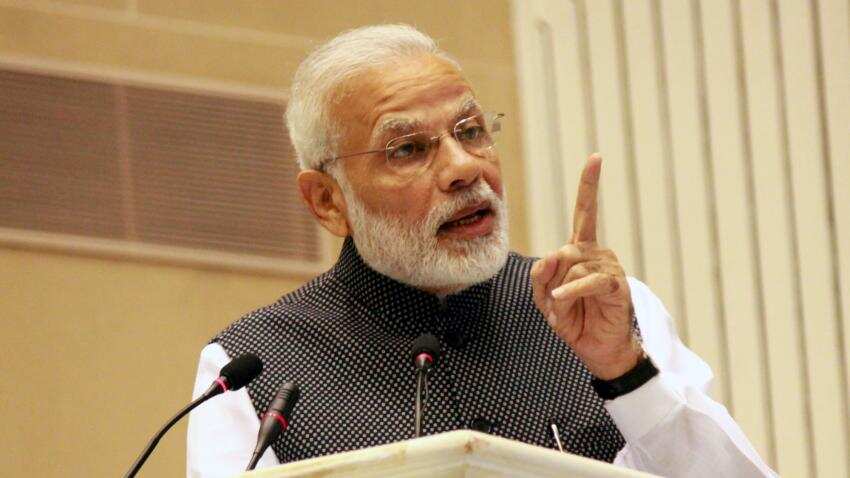On November 27, during an election rally in Uttar Pradesh, Prime Minister Narendra Modi urged all Indians get familiar and make others familiar with cashless transactions.
The same day, during his radio programme 'Mann Ki Baat', he said, "Learn how this digital economy works. Learn the different ways you can use your bank accounts and internet banking. Learn how to effectively use the apps of various banks on your phones. Learn how to run your business without cash. Learn about card payments and other electronic modes of payment. Look at the malls and see how they function. A cashless economy is secure, it is clean. You have a leadership role to play in taking India towards an increasingly digital economy."
Modi and his cabinet ministers have now launched a major social-media effort to promote cashless transactions, which include e-banking (or banking over computers or mobile phones), debit and credit cards, card-swipe or point-of-sales (PoS) machines and digital wallets.
ALSO READ: Demonetisation: PM Modi asks ministries, departments to go cashless
While India`s internet users surpass the US, smartphone ownership and internet penetration remain low. Also, as many as 68% of transactions in India are done in cash, according an analysis by Business Standard, while other estimates say 90% of all transactions are in cash.
Given this, there are five hurdles to Modi`s ambition of converting India to a cashless economy:
1. 342 million internet users, 27% of Indians: Earlier this year, India surpassed the US to become the country with the second-largest number of Internet users, according to this June 2016 report by investment firm Kleiner Perkins Caufield & Byers. There are 342 million internet subscribers (an Internet "penetration rate" of 27%) in India, data from Telecom Regulatory Authority of India (Trai) reveal.
The global median is 67%, IndiaSpend reported in March. India lags most major economies and performs worse than Nigeria, Kenya, Ghana and Indonesia, among other countries, the data reveal.
Put another way, 73% of Indians, or 912 million, do not have Internet access.
Of those who use the Internet, no more than 13% live in rural India (or 108 million of 833 million who live in rural areas), which has been worst hit by the November 8, invalidation of Rs 500 and Rs 1,000 notes that made up 86% of notes in circulation.
In urban India, 58% of people access the Internet.
2. Smartphone usage rate among adults 17%: For a majority of banking applications, a smartphone is a prerequisite. India is Asia-Pacific`s fastest-growing smartphone market, but no more than 17% of Indian adults own a smartphone, according to a survey by Pew Research. Only 7% of adults in low-income families own a smartphone; the figure for wealthier families is 22%.
3. 1.02 billion mobile subscriptions, but only 15% have broadband internet: India had 1.02 billion wireless subscriptions, but after scrubbing the data of inactive and duplicate connections, India has 930 million (90%) active subscribers, according to a Trai report. Of these, 154 million subscribers (15%) have broadband connections (3G plus 4G).
4. Average page load time on mobile 5.5 seconds, China 2.6 seconds: The average time to load a page on a mobile phone is 5.5 seconds in India, compared to 2.6 seconds in China, 4.5 in Sri Lanka, 4.9 in Bangladesh and 5.8 in Pakistan, according to the "State of the internet Q1 2016" report by Akamai Technologies, a global content delivery network services provider. Israel has the fastest load time at 1.3 seconds.
Mobile Internet speeds will make users less likely to use their phones for banking transactions, with Oracle Maxymiser, a website optimisation tool by Oracle, a US multinational, reporting a two-second threshold before users stop an online transaction -- although 68% of respondents reported they would not wait six seconds for pages or images to load on a bank`s website or mobile site.
5. 856 PoS machines per million Indians: There were 1.46 million point-of-sale (PoS) machines in use in India -- that is, 856 machines per million people -- according to an August 2016 Reserve Bank of India (RBI) report. In 2015, Brazil -- with a population 84% lower than India -- had nearly 39 times as many machines (32,995), according to a report by Ernst & Young, a consultancy. The PoS machine rate was 4,000 per million people in China and Russia.
More than 70% of the PoS terminals are installed in India`s 15 largest cities, which contribute to more than 75% of transactions, says the Ernst & Young report. This has not changed after #notebandi, as the scrapping of Rs 500 and Rs 1,000 notes is called colloquially.
Most requests for more PoS machines are still from tier-I, or metropolitan, cities, a banker with a leading private sector bank told the Indian Express on November 29. "In tier-II cities, customers are now slowly making the shift from using their debit cards to withdraw cash to using them for payments. The demand is progressing slowly," he said.
As an incentive to banks and manufacturers of PoS terminals, the government has waived 12.5% excise duty and 4% special excise duty on these machines, as it hopes to install an additional one million PoS machines by March 2017.
ALSO READ: Brands go for cashless ads to attract cash-crunched consumers
03:20 PM IST







 Digital banking may eat into ATM business
Digital banking may eat into ATM business Demonetisation: PM Modi asks ministries, departments to go cashless
Demonetisation: PM Modi asks ministries, departments to go cashless Ensure 100% cashless dealings within 15 days deadline: Ram Vilas Paswan
Ensure 100% cashless dealings within 15 days deadline: Ram Vilas Paswan Brands go for cashless ads to attract cash-crunched consumers
Brands go for cashless ads to attract cash-crunched consumers Notes ban likely to impact cashless economy, bonds: India Ratings
Notes ban likely to impact cashless economy, bonds: India Ratings